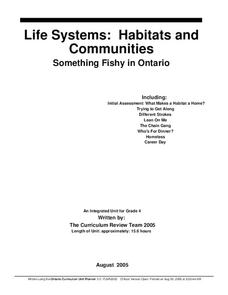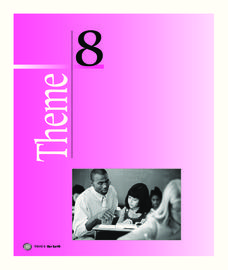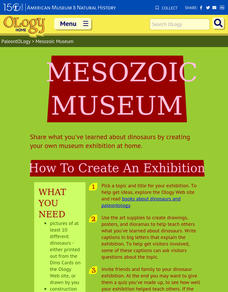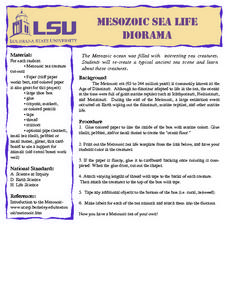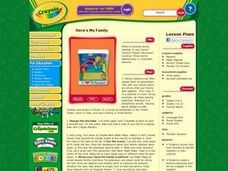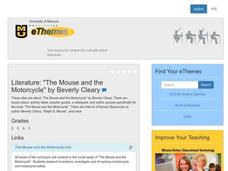Project Based Learning Teacher Resources
Find Project Based Learning lesson plans and worksheets
Showing 878 resources
Leading Learner
Using Music to Tell a Story or Describe a Scene
Young composers demonstrate their understanding of the stylistic features of descriptive music, including pitch, tempo, dynamics, rhythm, and timbre, by developing a melody and countermelody for a main character in a story. As part of...
Curated OER
Something Fishy in Ontario
Students create a diorama of the habitat of the fish of their choice, along with a research paper. They research habitats, the factors which affect specific habitats, and how fish adapt to different habitats in order to meet their unique...
Curated OER
Environment: Endangered Mammal Project
Students research different mammals and create illustrations and narratives about them. Working individually or in small groups, students compose their rough drafts prior to creating their posters or dioramas. Students present short...
Houghton Mifflin Harcourt
Our Earth: Challenge Activities (Theme 8)
This packet, the first in the series of support materials for the Houghton Mifflin Harcourt thematic units on our earth, contains enrichment activities for learners who have mastered the basic concepts of the lessons. Kids...
American Museum of Natural History
Mesozoic Museum
Mini museum curators create an exhibit that showcases the Mesozoic era. Pupils use their knowledge of dinosaurs to make informative posters, drawings, and dioramas. Following three steps to complete the hands-on activity, scholars read...
Curated OER
Twelve Angry Men
Students assess their understanding of Twelve Angry Men. They create flashcards for vocabulary terms, summarize one of the acts, construct a diorama and complete character wheels. They choose from other activities including creating...
Curated OER
Vertebrate Dioramas
Students are able to describe the development of their chosen form of vertebrate life from the past to the present in a four to six page typed paper. They explain the use of phylogenetic tree. Students use the phylogenetic tree to...
Curated OER
Vertebrate Dioramas
Students describe the development of their chosen form of vertebrate life from the past to the present in a four to six page paper. They explain the use of a phylogenetic tree, and use this to exemplify an organism's evolutionary change...
Curated OER
Mesozoic Sea Life Diorama
Students create a diorama depicting Mesozoic sea life. They color a template and add shells and pebbles to the diorama to depict the ocean floor.
Curated OER
The Polymer Schoolhouse
Students investigate polymers by discovering and examining plastics and creating a diorama.
Curated OER
Aquatic Shapes
In this artistic activity, students utilize a set of twelve aquatic shapes for their dioramas, posters, book covers and stick puppets. Students in addition color each shape with vibrant colors.
Curated OER
Dinosaurs 1: Where Are the Dinosaurs?
Students explore dinosaurs. In this dinosaur identification lesson plan, students watch video clips for different dinosaurs from the Discovery Kids website. Students discuss the clips with their teacher. Students may then role play the...
Curated OER
Art Lesson Plans
Young scholars participate in art projects based on their teacher's ideas. In this art lesson plan, students and teachers choose from a variety of art projects including collages, dioramas, masks, and more.
Curated OER
Here's My Family
Family traditions help to instill personal values, social norms, and the warmest of childhood memories. Elementary and secondary learners share their favorite family traditions with a fun diorama project. Using modeling clay, they create...
Curated OER
Social Studies Wonders: An Exploration
Help middle schoolers conduct Internet research and develop a working definition for the discipline of social studies. From a list of websites, they develop classification skills and differentiate between primary and secondary sources....
Curated OER
Amish Quilters
Students research information about the Amish way of life and discuss how quilting is a necessity as well as a way for women to socialize within the Amish community. They create a diorama showing scenes related to quilting.
Curated OER
Deep Inside a Cavern
Students describe how different types of caves and their physical features were formed. They distinguish between stalactites and stalagmites (stalactites grow down from the roof of a cave and stalagmites grow up from the floor)....
Curated OER
What Causes Big Waves?
Students use the internet to research how waves are formed. Using construction paper, they create a diorama in which they can see how waves are formed and end. To end the lesson, they also discuss the causes and effects of earthquakes...
Federal Reserve Bank
Retirement Planning
It's never too early to start saving for retirement. In fact, the earlier one starts, the better! Use this retirement planning activity to teach the importance of a retirement strategy and why to start at a young age.
Curated OER
Alternative Ideas for Book Reporting in Primary Grades
Looking for a new way to have your students complete book reports? Then, this lesson is for you! Young learners read literature of their choice and complete diorama, filmstrip maker, costume and letter, or puppet making activities...
Curated OER
Art--"Paper Pasting"--Doing Collage
In this art worksheet, students read a 1 page article on the history or art, prepare their background to making a collage, gather basic shapes, create their collage and then add in the finishing touches to them.
Curated OER
Illnois River and Lake Mussel Habitat Diorama Activity
Students identify the environmental elements of river and lake mussels. They compare the elements to the time before settlement and during industrialization. They also participate in a field trip to a mussel exhibit.
Curated OER
The Mouse and the Motorcycle
Students read Beverly Cleary's The Mouse and the Motorcycle. They review various interactive Web sites containing quizzes and activities related to the book.
Curated OER
Sheep To Sweaters
Students discover how sheep fleece is turned into yarn by hand. Individually, students research historic websites that shows sheep shearing. They create a 3D diorama of the historic procedure for making sweaters. They compliment the...



